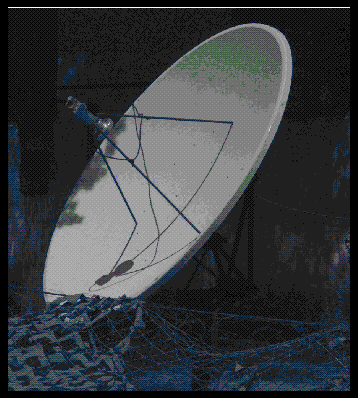Communications
The U.S. military provided communications equipment and personnel to support the Bosnian municipal elections, 13-14 September 1997. The military communications mission included supporting nonmilitary organizations. Several organizations supported the elections process, but two received extensive support: the OSCE and the IPTF.

Communications Support to Elections
The headquarters of the American-led Multi-National Division (North) was located at Eagle Base, Tuzla. The G6 signal officer of MND(N) was responsible for planning and implementing a significant piece of the election communication support. This support included organizing the communications exercises (COMEX) that tested the phone, FM and satellite networks. The multiple phone networks available to elections personnel consisted of local PTT, Sprint commercial, and tactical.
SUPPORTING SYSTEMS
Several NATO communications systems provided support to the elections. They included the Danish Trunked Telephone System (DEOS), the United Nations Very Small Aperture Satellite Terminal (VSAT), the Integrated Peace Support Network (IPN), and the commercial satellite system (INMARSAT). The challenge for the division signal officer was to ensure that OSCE personnel were able to talk to SFOR, especially in the event of violence at the polling stations or other emergency situation. The one asset extensively used was the American Single-Channel Tactical Satellite (TACSAT) terminals using PRC-117s and similar equipment. The TACSAT was the only unifying means of secure, terrain independent communication that every one of the 13 OSCE Regional Offices could access.
Telephone
The local Bosnian PTT phone network provided OSCE personnel telephone service to most of their election sites. The drawback to this service was its questionable reliability. The network extended north of the Inter-Entity Boundary Line (IEBL) to former Serbian-held territory with approximately five lines. This cross-IEBL PTT communication network could not be guaranteed. The Sprint phone network was able to support the OSCE and IPTF with commercial quality service but did not cover all of the election offices either. The mobile subscriber equipment (MSE) tactical network run by the MND(N) Signal Battalion supported the elections with secure telephone service but did not cover all election offices.
SATCOM
 The
use of TACSAT equipment for this operation was much greater than units were
accustomed. The equipment and available frequencies for satellite communications
are a finite asset. Yet, the number of TACSAT terminals used for the elections
reached more than 80, an extraordinary amount. The total number of satellite
nets available to a division is limited. Therefore, MND(N) operations and intelligence
satellite net (O/I) doubled as the elections net. Problems with this arrangement
included excessive routine traffic and a lack of a dedicated net control station.
An additional division satellite net was not authorized for the elections.
The existing satellite coverage did enable OSCE and IPTF personnel emergency
access to SFOR support.
The
use of TACSAT equipment for this operation was much greater than units were
accustomed. The equipment and available frequencies for satellite communications
are a finite asset. Yet, the number of TACSAT terminals used for the elections
reached more than 80, an extraordinary amount. The total number of satellite
nets available to a division is limited. Therefore, MND(N) operations and intelligence
satellite net (O/I) doubled as the elections net. Problems with this arrangement
included excessive routine traffic and a lack of a dedicated net control station.
An additional division satellite net was not authorized for the elections.
The existing satellite coverage did enable OSCE and IPTF personnel emergency
access to SFOR support.
The units that provided satellite and FM communications support to OSCE and IPTF received the equipment and initial training from MND(N) G6 personnel. The extra satellite equipment needed to support the elections was provided by assets in Germany. The G6 conducted a train-the-trainer class for the communications soldiers who signed for the equipment. Those soldiers returned to their units and trained their personnel because few soldiers had experience working with the TACSAT equipment.
The soldiers operated in small teams during the actual elections. For instance, a unit provided three teams of communication soldiers, four men per team, to support the OSCE regional offices in Brcko, Srebenic and Orasje.
Task Force Eagle units provided additional communication assets and personnel to support Non-Governmental Organizations (NGOs) and International Organizations (IOs) during the municipal elections. The Office of the High Representative, part of the implementation mechanism of the GFAP, required TACSAT and FM communications support from one TFE element.
Motorola
Several TFE eagle units supported the IPTF by installing and maintaining a series of mobile radio repeaters to extend IPTF's Motorola coverage. The following diagram charts the Motorola repeater network.

FM Radio
The mountainous terrain of Bosnia-Herzegovina reduced the operating range of Combat Net Radios (CNRs). CNR refers to single-channel and frequency-hopping FM radios used in maneuver units as their primary means of communication. The Single-Channel Ground and Airborne Radio System (SINCGARS) was the primary radio system used for short-range secure-voice communications within Task Force Eagle during the elections.
Two things were done to extend the limited range of the SINCGARS. An extensive retransmission (RETRANS) network was established to ensure that units communicated throughout the area of operation and SFOR authorized units to stop using the radio's frequency-hopping capability. In the frequency hopping mode, the radio's transmission changes frequency over 100 times per second. This prevents hostile interception and jamming units from locating or disrupting friendly communications.
It was found that this capability decreased the operational range of the radio, in some cases by 30 percent. The limited threat of hostile jamming allowed the decision to be made in favor of operating in the single-channel secure mode. The major hill tops in the American sector housed FM RETRANS stations. See the following chart.

TTP:
|
|
NEWSLETTER
|
| Join the GlobalSecurity.org mailing list |
|
|
|

